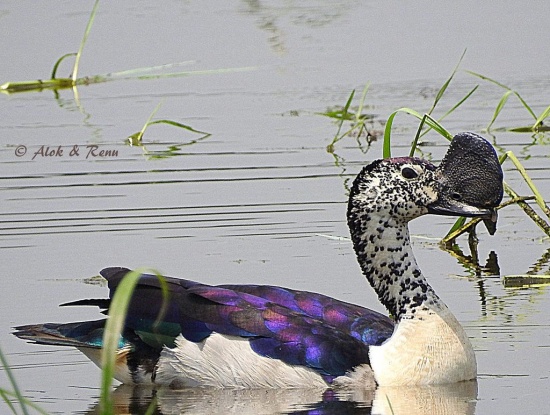- Sarkidiornis melanotos
Alternative name: African Comb Duck
Identification
55–63 cm (21-25)
- Glossy blue black upperparts
- White underparts
- Blue and green iridescent secondaries
- White head with dark spots
- White neck
Male - larger with large black knob on the bill
Juvenile
- Dull buff underparts, face and neck
- Dull brown upperparts, crown and eyestripe
Distribution
Sub-Saharan Africa, Madagascar, south Asia, Pakistan, Laos and extreme southern China.
Taxonomy
This is a monotypic species1.
Formerly considered conspecific with Comb Duck from South America.
Habitat
Wetlands, freshwater swamps, rice fields and lakes.
Behaviour
Diet
The diet for both subspecies is mostly vegetarian, with grass, seeds and rice grain; supplemented with small fish and invertebrates.
Breeding
They nest in tree holes and tall grass. The nest is lined with reeds, grass, or feathers. 7-15 yellowish-white eggs are laid; incubated by the female for about 30 days.
References
- Clements, J. F., T. S. Schulenberg, M. J. Iliff, D. Roberson, T. A. Fredericks, B. L. Sullivan, and C. L. Wood. 2018. The eBird/Clements checklist of birds of the world: v2018. Downloaded from http://www.birds.cornell.edu/clementschecklist/download/
- Hockey, PAR, WRJ Dean, and PG Ryan, eds. 2005. Roberts' Birds of Southern Africa. 7th ed. Cape Town: John Voelcker Bird Book Fund. ISBN 978-0620340533
- Handbook of the Birds of the World Alive (retrieved June 2015)
Recommended Citation
- BirdForum Opus contributors. (2025) Knob-billed Duck. In: BirdForum, the forum for wild birds and birding. Retrieved 5 February 2025 from https://www.birdforum.net/opus/Knob-billed_Duck
External Links
GSearch checked for 2020 platform.





